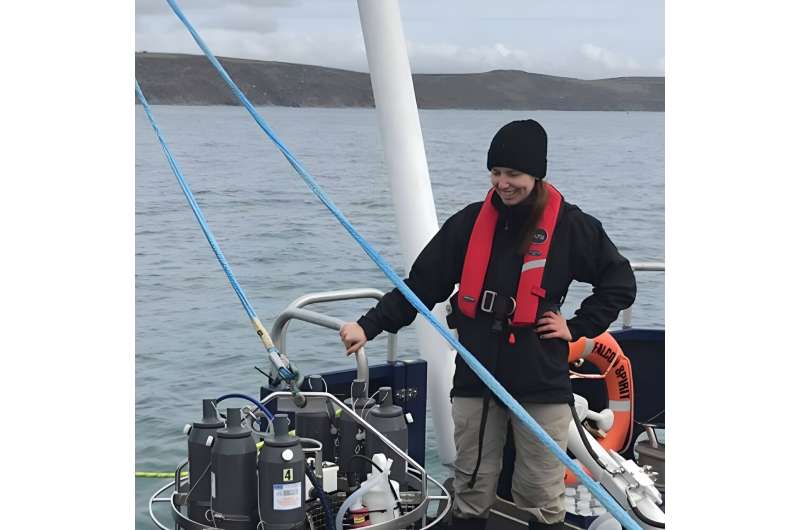This article has been reviewed according to Science X's editorial process and policies. Editors have highlighted the following attributes while ensuring the content's credibility:
fact-checked
peer-reviewed publication
trusted source
proofread
Significant shifts in inorganic carbon and ecosystem state in a temperate estuary

In the 1980s, the Elbe estuary had largely lost its function as an estuarine filter due to heavy metal pollution. After decades, the estuary was able to recover from this, as a team led by doctoral student Louise Rewrie from the Helmholtz-Zentrum Hereon has discovered by measuring carbon and other parameters.
Only in the last few years have the biogeochemical processes in the Elbe River Estuary resumed naturally. The study results were recently published in the journal Limnology and Oceanography.
River estuaries can recover from many years of pollution if they are given the time. This is the result of a long-term study in which a team of researchers led by marine science Ph.D. candidate Louise Rewrie from the Helmholtz-Zentrum Hereon evaluated water samples from the Elbe River over a period of 33 years. The data show that it takes several decades for the habitat and its biological and biogeochemical processes to return to a natural level. Accordingly, environmental protection measures must be planned for the long term.
Elevated pollutant input
As the scientists write in the current issue of the journal Limnology and Oceanography, the Elbe was extremely polluted in the mid-1980s. At that time, wastewater from industry and households flowed into the river almost untreated. Particularly large amounts of pollutants entered the Elbe upstream from industrial plants in what was then East Germany and Czechoslovakia—especially toxic heavy metals. In addition, there were large quantities of nutrients from untreated wastewater and from agriculture.
The Elbe estuary was in a correspondingly bad state. It was only after the fall of the Iron Curtain that massive investments were made in wastewater treatment plants in the Czech Republic and the new German states. As a result, the condition of the Elbe estuary improved between 1991 and 1996. "Only since 1997 can we speak of a recovery," says Louise Rewrie.
For the study, Rewrie analyzed water samples taken between 1985 and 2018.The water samples originate from regular helicopter flights, which are still carried out today by the Elbe River Basin Community. Water samplers are lowered at certain points along the Elbe estuary. The advantage of aerial surveys is that the entire estuary area from Geesthacht east of Hamburg to the bird island Scharhörn far out in the Elbe estuary can be sampled within a few hours.
This provides a snapshot of the pollution situation for the entire estuary, which is about 150 kilometers long, in a short time. Various chemical, physical and biological parameters are then measured, such as the oxygen content or the pH value, the acidity of the water.
Ecosystem state changes
The researchers found that heavy metal levels were above the targets, that have been set by the "International Commission for the Protection of the Elbe River" (ICPER) for aquatic communities in the Elbe River Estuary between Hamburg and the North Sea in the mid-1980s. The high and toxic levels of heavy metals likely affected growth of phytoplankton—tiny microalgae and single-celled organisms.
This was indicated in the data—especially in the amount of "dissolved inorganic carbon" (DIC), which includes carbon dioxide, carbonate or dissolved carbonic acid. Plankton absorb DIC molecules from the water and metabolize them as they grow and reproduce. In intact estuaries, the amount of DIC varies with the metabolic activity of plankton and other organisms.
In the polluted Elbe estuary of the 1980s, however, DIC processing came to an almost complete halt because organisms thrived poorly. DIC processing virtually only occurred far out beyond Scharhörn, because the pollutants were more dilute there.
"Estuaries act as important filters worldwide," says Dr. Yoana Voynova. "They filter nutrients and the nutritious remains of dead plankton that would otherwise go directly into the coastal sea. Highly polluted estuaries may lose this filtering mechanism.
"This can then lead to overfertilization of coastal waters and consequently to oxygen deficiency"—a situation that was more common in the 1980s. Voynava supervised Rewrie's work together with Prof. Burkard Baschek, who is now director of the German Oceanographic Museum. For him, the work is a clear indication that estuaries sometimes take many years to decades to recover from widespread pollution or alteration.
"Human intervention in estuaries must therefore be approached very cautiously. Environmental disasters, such as those that occurred in the Oder River in 2022, and increasing drought in summer should also be viewed with concern due to the long regeneration times," says Baschek.
Thanks to environmental protection measures, the Elbe estuary has been able to recover. Today's picture is a new state in which biology is functioning again. Recognizing and defining this natural state of ecosystems is also important for climate research, says Voynova. "Depending on which biogeochemical processes dominate in estuaries, they can absorb carbon dioxide or release it into the atmosphere. To properly assess their influence, we need to observe and understand the natural processes—in disturbed estuaries like the Elbe in the 1980s, this is hardly possible."
She says it is important to look at the different sections of a river estuary separately because different processes take place there—for example, upstream, where the water is more fresh, or further out, where the influence of seawater is greater. Therefore, the Elbe estuary between Geesthacht and Scharhörn was divided into seven sections for this study.
More information: Louise C. V. Rewrie et al, Significant shifts in inorganic carbon and ecosystem state in a temperate estuary (1985–2018), Limnology and Oceanography (2023). DOI: 10.1002/lno.12395
Journal information: Limnology and Oceanography
Provided by Helmholtz Association of German Research Centres




















